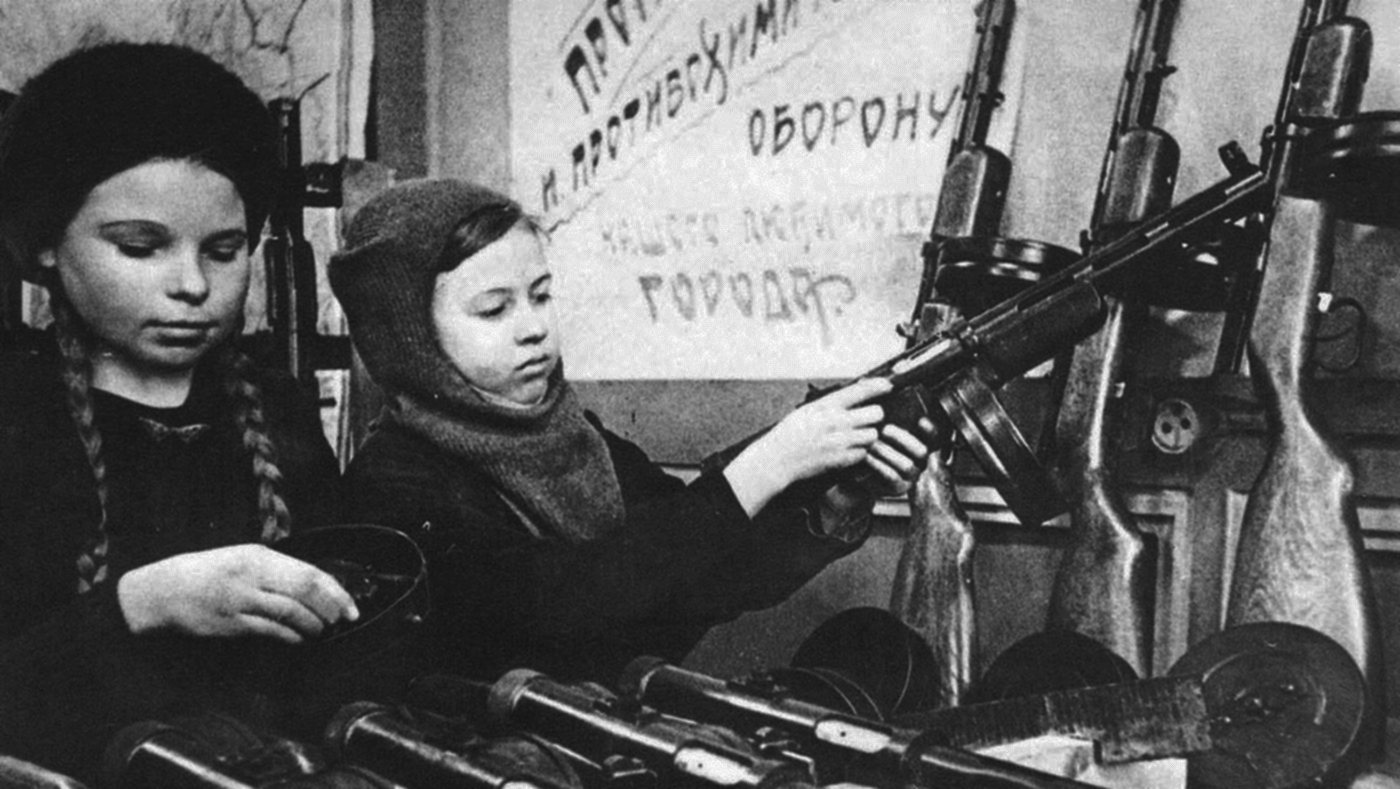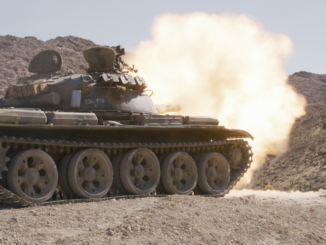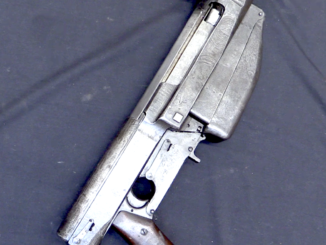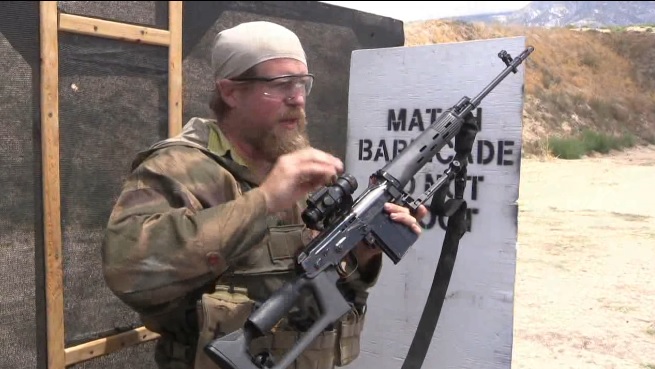
PPD-40 submachine guns being assembled by young girls.

Try out World of Tanks with a special bonus tank using this link! https://tanks.ly/3dqGoBL Today Nicholas Moran (the Chieftain) and I are at Battlefield Vegas courtesy of Wargaming.net, to show you around a Soviet T-62 […]

Prior to World War Two, the Soviet Union had a rather lackluster interest in antitank rifles – a series of guns were developed, but slowly and without all that much success. The Barbarossa invasion gave […]

This isn’t exactly a “forgotten” weapon, but it is a very cool one, and one we have been unable to pry out of Karl’s hands. In the recent May 2-Gun Action Challenge Match, Karl opted […]
© 2025 Forgotten Weapons.
Site developed by Cardinal Acres Web Development.

Huh, do you really want children assembling your PPDs? Careful if their smart enough to assemble sub-machine guns, Stalin might have them purged 😉
War related industrial production in U.S. led among other thing to large scale employment of women; phenomenon unknown until then. Pictures proving female work-force used on aircraft building is of common knowledge. In Canada as probably was case in UK as well, women made up large portion of factories staff.
In soviet Russia, since women have their broadly ranging responsibilities (there were even tank driver among them, not to mention snipers), there was still need for more. Therefore it should be no surprise that everyone took their patriotic duty as a matter of highest honor – including children.
If history was to repeat itself, I am pretty sure that kids would not stay idle. That is part of Russian character.
According to Wm L Shire’s book the Nazis did not want housewives to work in factories, thus they used slave labor, or laborers from other countries (who usually could not read German). The housewives were better used in raising up the Aryan race, so thought Hitler.
In the US women entered factories (and railroads and just about everything else) and so did some racial groups previously excluded. There were training programs (i.e., the Training Within Industry series) that sought to find continuous improvement from the workers on what they were making and how they made it–unthinkable with slave labor or with workers who did not know the language. German POWs were used for agricultural labor, not in industry. The industrial per-worker productivity was reported to be three times greater in the US than in Germany. A big difference between free and slave labor, although not being bombed regularly helped–speaking of which, the inability of the Nazis to bomb Russian industry beyond the Ural Mountains was surely a critical factor in the war.
During first years of WWII many (mostly young) residents of occupied Europe were assigned to what is termed “slave labour” – inside of German Empire. This is easy to understand with massive war effort required by German industry and men fighting on front. My own father was sent to work in steel construction plant in Danzig, currently Gdansk, from which he managed to escape thanks to crafty scheme. After clandestine return to Protectorate (of Bohemia-Moravia) he was hiding to the end of war to escape attention of authority. From this is easy to understand, that German women did not have to go thru same ‘social transfer’ as did those on Allied side. Of course, they were on receiving side, after the war’s end.
As far as use of German POWs I read and heard several times; for many of them it was welcome opportunity to escape the suffering from results of war and defeat. Those who found themselves in Canada and U.S. often stayed and started new existence. They became loyal Canadians and Americans. Record seem to suggest that their participation, in what they were assigned to do as POWs, was praiseworthy.
Quite so, Denny, and well said. The same also applied to many Italian POW’s.
True enough, Earl. Italians were in the same basket. I had once neighbour, whose mother was Italian to become a Canadian. Her future husband, himself of English background, had to make special request to grant her necessary status to merry her. It’s amazing what war makes out of people.
There is also the story (allegedly true) of a German POW in the UK that was released from the prison camp to tend to an old ladies cottage garden after the German surrender.
He was given the task of planting crocuses in the lawn edge (it’s an English thing – don’t ask).
The following spring (1946) the crocuses grew and spelled out “HEIL HITLER”. The lady commented “He seemed such a nice boy, too …”.
Good points, Jacob. I have read William Shirer’s book several times over, and it is remarkable how his research has generally withstood the test of time and the revelation of new, previously-unknown information. Although some details of his original work have since been put to question, the essential facts still hold up to scrutiny. Still a work well worth reading for the broad perspective it provides about Nazi Germany and World War Two.
I read a German book on the Eastern Front (in translation), from which it could transpire, that there was some method in the apparent madness of Stalin’s ordering to hold at any price and refusing the permission to withdraw, even when the situation was tragical (for example at Kiev, in 1941, where losses in prisoners alone amounted to 650,000) – namely, that he wanted to gain time to transfer the heavy industries beyond Urals. And you have to remember that the core of Russian armament industry – Putilov Works – was situated some 20 miles from the Finnish border.
This also made me give a second thought to Stalin’s decision of turning back the trains with civilians already being evacuated from Leningrad. Human nature being what it is, they would be families of the elite, so this may have been like keeping them as hostages for good behavior of their parents.
Regards, Andrzej
In the USSR in 1941-45 many workers on military plants was 13-15 years old. Usually they work half or less part of woeking day of adult workers
Good point, Pavel. If you don’t mind my asking, do you have any additional information about working conditions for these children that you could share with the rest of us? Thanks in advance.
Yet another face of total war. If things had gone worse for the Soviets, no doubt children would have carried those weapons into the final battles.
I think it tells us how incredibly difficult and desperate those times were, and how ugly the face of war, let alone total war, is.
That may be well true, John. It was pretty desperate. I remember hearing people who witnessed combat operations in Slovak part of Carpathian mountains. They said to us that Red army was driving foot soldiers into front line without rifles, just with sticks and vodka soaked brain. When guy next to him fell, then he was able to get ‘his’ rifle.
You might get the dead guy’s rifle, but you must loot his corpse for any ammo too. Plenty of guns, but very little ammunition… Or just use the rifle as a pike since it likely has its bayonet fixed already. Sneak towards the front, stab a German soldier, and take his stuff after that.
This is what we heard from ‘witnesses’ since the event of our visit into the area took place some 20years after the war. They were also telling us that German gunners are going amok as they were running out of ammo in face of incoming human waves (so called Dukla operation was largest in the area and crucial for Read Army breakthrough) Was the account accurate? I cannot tell and was not in position to question adults at the time.
In broader sense we know that basic infantry weapons were always in short supply, on both sides. When we look at huge amount of small arms acquired as trophy at beginning of war by Germans (see one of recent articles) it certainly does not make lots of sense. But, what makes ‘sense’ in a war anyway?
As far as I know, the Germans never had 7.62x54R ammo in their regular supply train. That limited the use of captured Russian infantry weapons to local use as long as captured ammo stocks lasted. They were often given to the Ukranians and Russians fighting for the Germans, which we now know was not an insignificant number of people. That is consistent with the fact that ammo was in even shorter supply than actual weapons and diverting ammo manufacturing capacity from 7.92×57 would have been a mistake. On the other hand, the numbers of captured weapons in 7.92×57 were not THAT great compared to the size of the German armed forces.
Only towards the end of the war weapons in non-standard calibers were issued to fortification and Volksgrenadier units, although captured local weapons were used in France and Italy before that, especially in fortifications.
Frankly I think that is a propaganda photo. The PPD40 was a well made gun, which is why it could not be mass produced under war conditions. It was not the sort of piece to be assembled by children.
The PPD-40 was indeed a very well made gun, and its predecessors, the PPD-34 and PPD-34/38 perhaps even more. I had an oportunity to inspect a PPD-34 once and was quite impressed by the quality of fit and finish, in contrast to the later PPD-40 (not to mention the mass-produced PPSh-41)…
I agree; seeing them side by side in museums as I did at my early time, it was obvious that PPSh-41 is pedestrian compared to PPD. In that sense, the Soviets did right step while replacing former for the latter.
Same time and because of what is stated above, it makes me to question validity of picture vis-a-vis Leningrad siege. But, I respect Mr. Popenker’s view.
I’m sure there were plenty underage assemblers of STEN parts in Britain during their dark days…
Hard to tell, unless we have a proof. It is known however that many civilians, mainly children were shipped out of Britain.
http://en.wikipedia.org/wiki/Evacuations_of_civilians_in_Britain_during_World_War_II
Related, but separate affair were so called “wartime wives” – basically young British women choosing to come to Canada. I believe, there were several thousands of them.
it’s not just children. its chieldren of besieged Leningrad, if you know what it means
Exactly, Max. In wartime, pure expediency trumps all other considerations , especially when things become really desperate, as in last-ditch desperate. It is what a society of any type may be forced to resort to — no matter how reluctantly — if it is to survive the onslaught ( the heinous, murderously deliberate usage and exploitation of child soldiers in recent decades in numerous conflicts in Africa by certain warlords would be the outstanding exception to this ). I have also read that the children on some of the wartime assembly lines were deliberately chosen for the role because their quick young minds and great manual dexterity ( remember when we were like that too? ) were ideally suited to weapons assembly.
I do know about the siege of Leningrad, but that does mean this photo is not a propaganda piece. The image of charming children assembling a precision made pre-war SMG in front of stirring posters is too good to be true.
Well, in some ways it’s propaganda; but PPD-40 were assembled in Leningrad until 1942. And a lot of child, female and veteran labour was used in its production, because most able men were either at the front or doing some harder labor.
MY grandpa got a combat medal for doing naval engine repairs in Kronshtadt dockyards during the winter of 1941-42. You can guess how hard it was there if even a repair work at the base was considered equivalent to combat.
Max, many thanks for sharing that bit of family history with us. I recall a similar situation in my own family, with a grand-oncle of mine who was awarded a high decoration for supervising high priority, round-the-clock repair work (armoured cars, tanks and artillery-related stuff) in a factory during the SCW.
Thanks for sharing that bit of information about your grandfather ; given the wartime political, military, economic, material and other circumstances of that terrible winter, and the fact that working around the clock to meet impossible demands at the great Kronstadt Naval Base was never a picnic by the wildest stretch of the imagination even at the best of times, I would say that he definitely earned his medal, and then some.
I always heard the fewer women were employed in arms factories under the Hitler regime than were employed in arms factories under the Imperial German Government of Kaiser Wilhelm II…It was a if the Nazi’s were looking for new ways to be regressive and backward. Interesting side note – children in Birmingham (UK not Al.) were involved in civilian arms manufacture well into the 1930’s and perhaps beyond due to the fact that many parts were fabricated or finished in home workshops and final assembly was done at the factory. Heard of a photo with boys wheeling a wheel barrow loaded with parts to or from a factory c.1920.
I find the Eastern Front interesting, since everyone of all ages and sexes were mobilized to fend off the Germans. Children were placed in the Factories since the males were either part of the Red Army, Fleet, Airforce or Militia. The Blockade of Leningrad saw everyone in the Front: some worked on building fortifications, in factories or part of militias.
it is interesting to think that a normal US bomber raid over germany featured, more or less, bombers made by american women dropping bombs made by american women over german cities inhabited by german women and children plus aged and infirm, defended by anti aircraft manned by german children and german fighters built by jewish and other slave laborers etc… the only real combatants were the operators of the aircraft. It would be interesting to see a scholarly analysis of this on all fronts.
You are very close to one final step – and this is not to be openly spoken for obvious risk of being called “conspiracy nut”. However… your mind is your own and your own playground. You do not need to be self-censored there, as long as you keep conclusions for yourself.
To confirm your findings – go to history a connect the dots. Picture is increasingly clear, very clear.
An excellent point about the supreme and terrible ironies of war.
I was under the impression the PPD was largely discontinued after 1941. Was this a “war time photo”?
PPD-40 was produced in Leningrad until replaced by PPS-42 in 1942.
This is answer to my previous suggestion. Also, we need to keep in mind that the first land contact made with city was in middle of January 1943. In that sense, emergency PPD production in Leningrad during Siege is likely scenario and the picture gains on credibility.
http://en.wikipedia.org/wiki/Siege_of_Leningrad
Well, if the factory in Leningrad didn’t have either the drawings or the tooling to produce the PPsH (and no realistic way of getting them into the city) but the factory was set up to produce the PPD40 then it is quite plausible that they would continue to produce what they could.
I suppose it could be a propaganda picture (I can imagine the captions “Even children are used to preserve freedom ..” or similar. But I think that it is unlikely that it was posed (in the sense of being not normal practice). More likely it’s simply a record of what went on in Leningrad at the time.
In the UK the school leaving age was 14 until 1947 when it went up to 15.
A relative joined the Army in 1938 to get out of working down the Welsh Mines which he hated, ironically he was in the rearguard at Dunkirk and so ended up working in a German mine until 1945.
In the UK children worked up to ten hour shifts in factories if they left the minimum age of 14, at 15 they could be put on to night shifts.
More remarkable was the official policy, introduced in 1940, of School Harvest Camps under which whole schools could be sent to help with harvests. These could be any kind of school with children from about age 9 up, whether already evacuated away from bombing or not, from the poorest inner city schools to the most expensive fee paying.
Younger children would usually be given lighter tasks such as soft fruit picking whereas older boys and girls could even be sent logging.
Participation was technically voluntary for both schools and children but the scheme proved extremely popular, so much so that the Italian and German PoWs whom children would often find themselves working alongside were amazed.
Lil over quarter pound of poor quality bread per day during chilly winter and still chubby cheeks?
Kid on left got thinned eyebrows(that’s what wife said) – set up photo?
12L14
That was my first impression, too. And after the Great Famine of the 1930’s.
HOWEVER, the fact that it WAS posed, and WAS INTENDED AS propaganda, does not have to mean that the practice illustrated was not true. The children (if they actually were – as, because of food shortages, they might look younger than their actual age) could have been selected from the children of the elite, as being “on hand”.
1. To start with your first argument, working in a factory could mean for a child a larger bread allowance.
2. Citizens of the country (like UK or USA)that had not been overrun by the enemy find it difficult to believe such practice as other than an effect of the coercion by an inhuman regime.
Actually, in an enemy-occupied country (like Poland), or partially overrun (like the USSR) children WANTED to help in the fight – in whatever form. And did not have to be forced (which is the implication that can be sensed in the posts of some of the skeptics).
3. If this was taken during the Siege of Leningrad, then by that time (it began in the fall of 1941) the USSR would have suffered EXORBITANT losses – in killed, prisoners (the Kiev operation alone rendered to the Germans 650 00 prisoners), and the civilians of the most populous regions.
4. I personally handled PPSh-41 – it is very simple. PPD-40 coud not have been that much more complicated to be ASSEMBLED to make it impossible, even for the untrained hands.
5. Speaking of using booty weapons – Germans could have passed on the weapons chambered to Mosin-calibre rimmed cartridges to the Finns, for whom this was a regular weapon and regular cartridge. At least in the initial period of the war, when they could have Mauser rifles in 7.93 calibre also from the over-run Czech and Polish factories. Still, you have to remember, that weapons in non-regular calibre could be supplied to non-front-line troops (Bahnschutz, Civil Defense). Then, things began to change when Germany started losing the war. My erstwhile Boy-Scout Guide, who had been a Flakhelfer in the final period of the war, said that at some time they had issued to them the Mosin 1944 carbines.
6. When the Germans captured large numbers of PPSh-41, they rebarrelled them to 9 mm Parabellum, using the Suomi drum magazines. They were much more reliable than MP-40’s.
7. As it was said, they may have produced PPD-40 in besieged Leningrad until the supplies of parts lasted. All the time they had been working on the simpler (and cheaper – and more modern) replacement for PPSh-41, which came in the form of PPS-42/43, which was actually constructed IN Leningrad during the Siege.
8. The British also started with a Lanchester (like PPD-40, a copy of German MP-28), but ended with a STEN (something the Germans also tried to do in the final years of the war).
Incidentally, the concept of the ‘PRECISION-MADE SMG”, beame toward the end of the war, an oxymoron for all parties involved (also Americans – from Thompson to MP-3)
Regards, Andrzej
You have some questionable or wrong items here
“When the Germans captured large numbers of PPSh-41, they rebarrelled them to 9 mm Parabellum, using the Suomi drum magazines“. have you any proof for that? because as far as I know, 9mm PPSh-41 were issued with adapters for 32-rd MP38/40 mags. In facts, some were dug up at the battle sites by my friends.
“PPS-42/43, which was actually constructed IN Leningrad during the Siege“. PPS-42 was designed at NIPSMVO small arms proving grounds site in Schurovo, near Moscow, during extensive trials program for a new SMG. Sudaev was sent to Leningrad to set up manufacture of PPS-42 there (as not to interfere with PPSh production, which was in extremely high demand in 1942). Only PPS-43 was designed in Leningrad.
I do not have any proof. I read both of those ifnormation in Hogg’s “Infantry Weapon of the Secodn World war” (ro something to that effect.
About #5:
Finland received 56,722 Mosin-Nagant rifles, most of them M91/30 models, from Germany in summer 1944. That must have been only a small fraction of Mosins captured by the Germans. Finland alone captured more than 100,000 Mosins during the war. To my knowledge no other weapons chambered in 7.62x54R were transferred to the Finns in significant numbers.
#6:
I have never heard Germans manufacturing copies of the Suomi 70-round (nominally 72-round) drum magazine, either. Finland did sell 1,300 Suomi SMGs to Germany and probably some 70-round drums were delivered with them. That could be the source of the information that Germans used Suomi magazines with re-barreled PPSh-41s.
Good for them.
Children need to grow up faster. Get work. Become adults.
Now we have 30 year old children hanging around in society, because we didnt brow beat the younger generations, and coddled them instead.